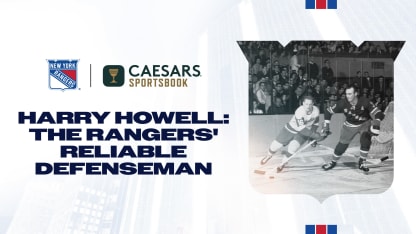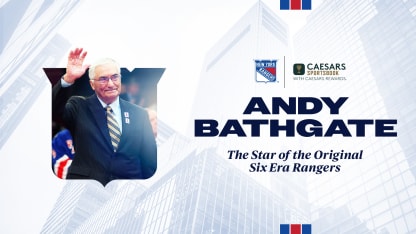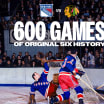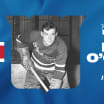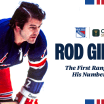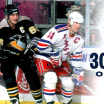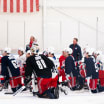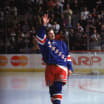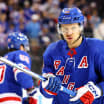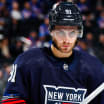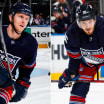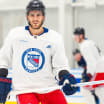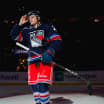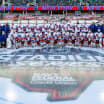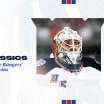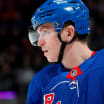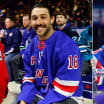The Rangers have advanced to the Stanley Cup Final in 11 different seasons in franchise history. One of those 11 teams, the Rangers of 1949-50, exemplified a “Cinderella Story”, as they went on an improbable playoff run that ultimately fell just one goal short of winning the Stanley Cup.
“The one word to describe that team was ‘lovable’,” hockey historian Stan Fischler said.
Lynn Patrick, who had been a star player for the Rangers in the 1930s and 1940s, began his first full season as the team’s head coach in 1949-50. And while Patrick helped the young team improve in several areas throughout the year, there was no doubt as the season progressed that the backbone of the team was goaltender Chuck Rayner.
Nicknamed “Bonnie Prince Charlie”, Rayner began his NHL career with the rival New York Americans during the 1940-41 season as a 20-year-old. After the Americans folded following the 1941-42 season, Rayner spent three years in the Canadian Navy during World War II. Upon his return for the 1945-46 season, Rayner learned that his rights now belonged to the other New York NHL team that called Madison Square Garden home.
Rayner had established himself as the Rangers’ number one goaltender by the conclusion of the 1948-49 season, as he appeared in 58 games and was named to the NHL’s Second All-Star Team. But the following season, Rayner had what was unquestionably the best season of his career, as he played in 69 of the Rangers’ 70 games and posted a career-best 2.62 goals against average. In addition, he won the Hart Trophy as the NHL’s Most Valuable Player, becoming just the second goaltender in league history at the time to be recognized with the award.
“Charlie Rayner was one of the greats,” Fischler said of the Hall of Fame goaltender. “Time and again, players on the other team were ramming into him and he was endured injuries to several parts of his body. But, he was a warrior and kept coming back.”
Throughout the season, the media began referring to the team as the “Rayngers” because of Rayner’s unquestionable impact. And while the Blueshirts might not have had an offensive superstar that rivaled the likes of Detroit’s Gordie Howe or Montreal’s Maurice ‘Rocket’ Richard, they had a group of players who could contribute offensively and – as the playoffs would show – rise to the occasion when the situation warranted it.
Buddy O’Connor, the Rangers’ captain in 1949-50, had won the Hart Trophy and Lady Byng Trophy in his first season with the team in 1947-48. As the elder statesman of the Rangers at 33 years old that season, O’Connor was the team’s emotional leader and still more than capable of scoring a goal when the Rangers needed one. Tony Leswick was named to the NHL’s Second All-Star Team at left wing in 1949-50, as he tied for the team lead with 44 points during the season.
But the Rangers’ key player besides Rayner that season was center Edgar Laprade, who led the team with 22 goals, tied for the team lead with 44 points, and as a result of only receiving two penalty minutes in 60 games to go along with his offensive totals, received the Lady Byng Trophy.
One of hockey’s premier two-way forwards, Laprade was relied on just as much to help the Rangers score a goal as he was to check the opposition’s best players and prevent one. In many ways, Laprade was the sequel to Frank Boucher, who had won the Lady Byng Trophy seven times in an eight-season span during his playing career with the Rangers. Ironically, Boucher – as a member of the Rangers’ front office – helped the team sign Laprade, who would play his entire 10-year Hall of Fame career with the Blueshirts.
Allan Stanley, who was the runner-up for the Calder Trophy as the NHL’s Rookie of the Year to teammate Pentti Lund in 1948-49, was in the second season of his Hall of Fame 21-year NHL career. Stanley was relied on more and more as the season progressed, and he helped anchor the defense corps throughout the team’s playoff run.
The Rangers finished the 1949-50 regular season with a 28-31-11 record, which put them in fourth place in the six-team league. A difficult 2-6-5 start to the campaign was salvaged when the Blueshirts posted a league-best 9-3-1 record in December. Laprade tallied 12 points (seven goals, five assists) in 13 games during the month, while Rayner posted a 1.31 goals against average (17 goals against in 13 appearances) with three shutouts.
The Blueshirts’ fourth-place finish in the regular season meant that they would face the second-place Montreal Canadiens in the Semifinals. The Canadiens finished the season with 10 more points than the Rangers, and most pundits expected Montreal to win the series. The Semifinals featured a prolific matchup in goal; even though Rayner won the Hart Trophy, Montreal’s Bill Durnan won the Vezina Trophy for posting the lowest goals against average in the league (2.20, compared to Rayner’s 2.62), and Durnan was selected to the NHL’s First All-Star Team while Rayner was selected to the league’s Second All-Star Team.
But as the series unfolded, a decision made by Patrick to use Lund, a right wing, as a “shadow” on Richard, the NHL’s leading goal scorer with 43 that season, proved to be what gave the Rangers the edge. With Lund playing against Richard on almost every even strength shift in the series, it was the Rangers’ No. 9 who outperformed Montreal’s famous No. 9.
In what ended up being a five-game series, Richard only scored one goal, which was on a power play. Meanwhile, Lund scored five goals and had nine points in the five games, including a hat trick in Game 3 of the series to lead the Rangers to a 4-1 win and a three-games-to-none lead.
Prior to Game 4 in Montreal, Durnan asked to be removed from the lineup in favor of goaltender Gerry McNeil. The Canadiens won the game, 3-2, in overtime, as Richard’s third period power play goal and Elmer Lach’s goal late in the first overtime period helped Montreal avoid a sweep. But in Game 5, Rayner, who had been hit in the face with a shot that resulted in three stitches and three loose teeth, prevented the Canadiens from scoring once. And with three goals in the third period from unsung heroes Jack Gordon, Pat Egan, and Dunc Fisher, the Rangers had eliminated the Canadiens with a 3-0 win at Montreal Forum.
Following the series win over the Canadiens, the Rangers would face the Detroit Red Wings, the team with the best record in the league during the regular season, in the Stanley Cup Final. With the series beginning in the second week of April, and with The Ringling Bros. and Barnum & Bailey Circus in full swing at MSG, the Blueshirts knew they would have to play the entire series away from New York.
The Rangers lost Game 1, 4-1, in Detroit, before traveling to Toronto for their two “home” games in the series. The Blueshirts split those two games, winning Game 2, 3-1, behind two goals from Laprade in the third period, before losing Game 3, 4-0.
Returning to Detroit for Game 4 (and the remainder of the series), the Rangers understood the daunting task in front of them, as well as the importance of tying the series. When Ted Lindsay and Sid Abel – two-thirds of Detroit’s famed “Production Line” and the NHL’s two leading point scorers during the regular season – scored in the first period to give the Red Wings a 2-0 lead, the Rangers’ challenge appeared even greater.
But the Blueshirts fought their way back. First, O’Connor’s goal with one second remaining in the second period gave the Rangers momentum heading into the third period. Detroit regained a two-goal lead early in the third period, but goals from Laprade and Gus Kyle helped the Rangers tie the game and send the contest into overtime. In the extra session, Don Raleigh, nicknamed “Bones” due to his slight frame, scored the game-winning goal to tie the series for the Blueshirts.
Two nights later, Raleigh put his name into Stanley Cup lore. Rayner had held Detroit scoreless for the first 58:10 of Game 5, but Lindsay’s goal with 1:50 remaining in regulation tied the game at 1. For the second straight game, the outcome would be decided in overtime. And for the second straight game, it was Raleigh who would score the game-winning goal, with this one coming less than two minutes into overtime.
In Game 6, the Rangers jumped out to a 2-0 lead in the first period and held leads of 3-1 in the second period and 4-3 in the third period. The Red Wings’ offense, however, put pressure on Rayner and the Rangers’ defense, and Lindsay and Abel each scored in the third period to give Detroit a 5-4 win and force a winner-take-all Game 7.
In the seventh and deciding game, the Rangers once again took a 2-0 lead in the first period. The Red Wings tied the game with two goals in a span of 21 seconds in the second period, and after O’Connor put the Rangers back in front late in the second period, Detroit once again tied the game before the period ended.
After neither team scored in the third period, the contest – and Stanley Cup winner – would be decided in overtime. In the first overtime period, the Rangers had a chance to win the game; which player had the chance – Raleigh, Laprade, Fisher – has been remembered differently as time has passed, but the memory of the result has been consistent, with the puck directly hitting the post behind Red Wings goaltender Harry Lumley and bouncing away from the net.
Nobody scored a goal in the first overtime period. Just over eight minutes into the second overtime period, Detroit’s George Gee won a faceoff and passed the puck to teammate Pete Babando. Babando took a backhand shot from approximately 15 feet away from the net. The puck eluded Rayner and entered the net, giving the Red Wings the win and the Stanley Cup.
Although the Rangers ultimately ended up just one goal short of winning the Cup, they could hold their heads high for the effort they gave and performance they had. Whether or not they would have won the Stanley Cup had they been able to play at MSG during the Stanley Cup Final is a question that has been debated, but ultimately cannot be proven one way or the other.
What is definite, however, is how special the 1949-50 New York Rangers were.
“For me, this was the most romantic Rangers team and had the most colorful players,” Fischler said as he reminisced about the squad. “You had to love this team.”


